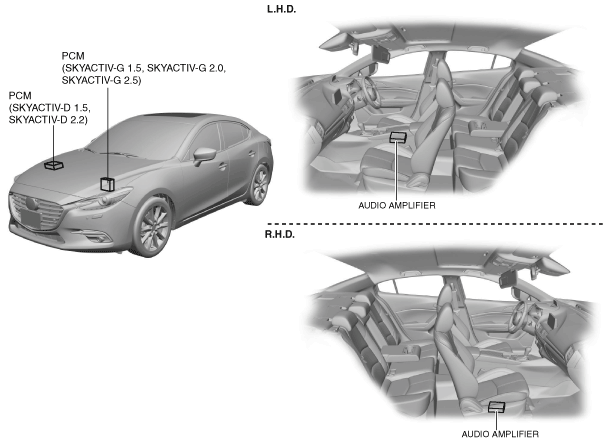 |
am3zzn00005708
AUDIO AMPLIFIER [WITH CENTER DISPLAY]
id0920zz011200
Purpose
Function
Current control function at engine restart by i-stop (With i-stop system)
Active engine sound function (With i-stop system, without i-ELOOP)
Construction
am3zzn00005708
|
Terminal Layout and Signal
L.H.D.
|
Terminal |
Signal |
|
|---|---|---|
 |
1A
|
—
|
|
1B
|
—
|
|
|
1C
|
—
|
|
|
1D
|
—
|
|
|
1E
|
—
|
|
|
1F
|
—
|
|
|
1G
|
AudioPilot® (+)
|
|
|
1H
|
AudioPilot® (-)
|
|
|
1I
|
Rear door speaker input RH (+)
|
|
|
1J
|
Rear door speaker input RH (-)
|
|
|
1K
|
Rear door speaker input LH (+)
|
|
|
1L
|
Rear door speaker input LH (-)
|
|
|
1M
|
Front door speaker input RH (+)
|
|
|
1N
|
Front door speaker input RH (-)
|
|
|
1O
|
Front door speaker input LH (+)
|
|
|
1P
|
Front door speaker input LH (-)
|
|
 |
2A
|
Rear door speaker output RH (+)
|
|
2B
|
Rear door speaker output RH (-)
|
|
|
2C
|
Front side speaker output LH (-)
|
|
|
2D
|
ACC
|
|
|
2E
|
Front side speaker output LH (+)
|
|
|
2F
|
Audio amplifier control
|
|
|
2G
|
Front center speaker output (+)
|
|
|
2H
|
Pulse width modulation (PWM) control
|
|
|
2I
|
Front center speaker output (-)
|
|
|
2J
|
i-stop control*1
|
|
|
2K
|
Front side speaker output RH (-)
|
|
|
2L
|
CAN_H
|
|
|
2M
|
Front side speaker output RH (+)
|
|
|
2N
|
CAN_L
|
|
|
2O
|
Rear speaker output (+)
|
|
|
2P
|
Rear speaker output (-)
|
|
 |
3A
|
B+
|
|
3B
|
Ground
|
|
|
3C
|
Front door speaker output LH (+)
|
|
|
3D
|
Front door speaker output LH (-)
|
|
|
3E
|
Front door speaker output RH (+)
|
|
|
3F
|
Front door speaker output RH (-)
|
|
|
3G
|
Rear door speaker output LH (-)
|
|
|
3H
|
Rear door speaker output LH (+)
|
|
R.H.D.
|
Terminal |
Signal |
|
|---|---|---|
 |
1A
|
—
|
|
1B
|
—
|
|
|
1C
|
—
|
|
|
1D
|
—
|
|
|
1E
|
—
|
|
|
1F
|
—
|
|
|
1G
|
AudioPilot® (+)
|
|
|
1H
|
AudioPilot® (-)
|
|
|
1I
|
Rear door speaker input LH (+)
|
|
|
1J
|
Rear door speaker input LH (-)
|
|
|
1K
|
Rear door speaker input RH (+)
|
|
|
1L
|
Rear door speaker input RH (-)
|
|
|
1M
|
Front door speaker input LH (+)
|
|
|
1N
|
Front door speaker input LH (-)
|
|
|
1O
|
Front door speaker input RH (+)
|
|
|
1P
|
Front door speaker input RH (-)
|
|
 |
2A
|
Rear door speaker output LH (+)
|
|
2B
|
Rear door speaker output LH (-)
|
|
|
2C
|
Front side speaker output RH (-)
|
|
|
2D
|
ACC
|
|
|
2E
|
Front side speaker output RH (+)
|
|
|
2F
|
Audio amplifier control
|
|
|
2G
|
Front center speaker output (+)
|
|
|
2H
|
Pulse width modulation (PWM) control
|
|
|
2I
|
Front center speaker output (-)
|
|
|
2J
|
i-stop control*2
|
|
|
2K
|
Front side speaker output LH (-)
|
|
|
2L
|
CAN_H
|
|
|
2M
|
Front side speaker output LH (+)
|
|
|
2N
|
CAN_L
|
|
|
2O
|
Rear speaker output (+)
|
|
|
2P
|
Rear speaker output (-)
|
|
 |
3A
|
B+
|
|
3B
|
Ground
|
|
|
3C
|
Front door speaker output RH (+)
|
|
|
3D
|
Front door speaker output RH (-)
|
|
|
3E
|
Front door speaker output LH (+)
|
|
|
3F
|
Front door speaker output LH (-)
|
|
|
3G
|
Rear door speaker output RH (-)
|
|
|
3H
|
Rear door speaker output RH (+)
|
|
Operation
am3zzn00005709
|
Engine restart by i-stop (With i-stop system)
am3zzn00005710
|
Active engine sound function (With i-stop system, without i-ELOOP)
am3zzn00005711
|
Fail-safe